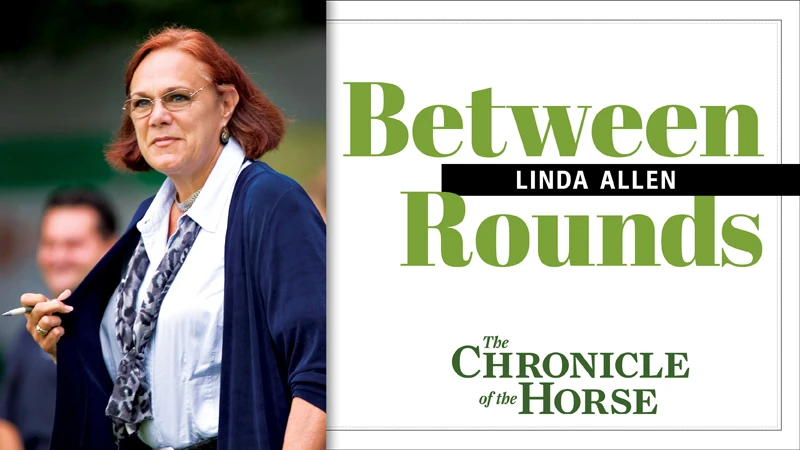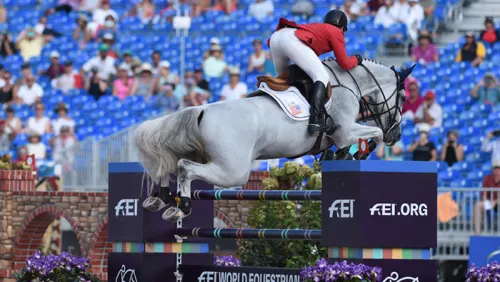Our columnist recalls the cyclical journey that the selection process has taken over the past few decades.
Jumping, like all equestrian sports, is a fickle game. With an endless variety of variables at play, not even the very best horse-and-rider combination is infallible on any given day. This situation means that selecting a team for an event such as the Alltech FEI World Equestrian Games comes to as much art as science.
With our own Kentucky Horse Park playing host for the first time in the 20 years since all international disciplines came together to comprise the WEG, the desire of our riders—and the owners of our horses—to be part of the elite group of four to ride in the championships is especially intense.
No one makes the team on a whim anymore. It takes years of planning and hard work to even consider one’s self in the running. Actually, reaching the goal will require just a bit of plain old good luck as well.
The process of reducing a large group of focused candidates down to the strongest possible team to represent the country isn’t an easy one. It’s especially true when the ultimate goal isn’t simply selecting the team but, most importantly, having those elite of the elite left with their best still in them when they walk into the arena during those early days of October.
Subjectivity In Action
My own experience with the selection procedure is long and varied.
I was still riding during the later years of the Bert de Néméthy era. A largely self-taught youngster, I read incessantly of the exploits of Bill Steinkraus, Frank Chapot and Kathy Kusner. Like so many others, I secretly harbored the most unlikely dream of representing my country internationally.
Coming from the West Coast, I heard the frequent refrain, “making the team is so political, without moving to the East Coast there is just no way…”
To my mind, it likely had less to do with politics but instead with the simple situation that the greatest depth and strongest sport in our country took place on the Eastern seaboard. In any sport, to reach and remain at the top you need to be testing your skills against the best as often as possible.
During the de Néméthy days, he alone selected riders and horses to represent our country. Despite his many efforts at seeking and developing riders and horses with international aspirations and potential, the number of candidates was far fewer than is produced by today’s much more extensive sport.
Despite the undeniable talent of the international stars of the day—even as late as the early 1980s—there were a limited number of possible team members. Selecting a well-balanced team could be done solely utilizing Bert’s vast knowledge, skill and experience. Disappointments hurt individuals terribly, but it could never be doubted that Bert alwaysput the success of the country first when it came to making hard decisions.
Within the coming decades, the situation changed tremendously as the sport at home, and the interest of riders in international participation, grew by leaps and bounds.
ADVERTISEMENT
By 1986, Bert had retired from his U.S. Equestrian Team position, and a new selection method had to be considered for the first time in recent history.
When a USET Selection Committee was formed for the 1986 World Championships team, I was honored to receive a phone call from Bill Steinkraus asking me to be the chairman. I was also naïve enough to accept the position.
My own international experience had been limited to Nations Cup participation at Spruce Meadows (Alta.) in the late 1970s, along with a summer as an individual rider in Europe with four horses and a surprise position on Bert’s “long list” early in the year of the ill-fated 1980 Moscow Olympic Games.
My interest had always centered on international sport, and I was designing courses quite extensively by then, so I felt excitement rather than trepidation about participating as one among the large group of highly qualified people forming this new committee.
We got a taste of how difficult the job could be right off the bat, however. We found that it isn’t all that easy to have the most experienced riders on the most experienced horses for every spot. Yet, a win in the team competition at Aachen (Germany) that year, along with Conrad Homfeld’s silver medal in the individual was satisfying for every committee member.
The “committee system” stayed in place for the next few years. Yet, as more and more qualified riders tried out for those coveted spots on Olympic and championship teams the difficulties with selection increased exponentially. Too few spots with too many equally qualified horse/rider combinations meant frustration and disappointment to those who worked hard, produced, and yet failed to be named.
Tumultuous Times
Despite writing ever more complex rules regarding observation trials, one Olympic Games and one (the first) World Equestrian Games were marred by legal proceedings over who should occupy the final spot on the team.
The process was vindicated, but following these experiences the pendulum swung to strictly objective team selection. Mandatory Trials were held for every major event with rules designed to ensure that every competitor started on absolutely equal footing.
In a sport where experience is so important—a strong international record is difficult to come by and is the best predictor of future success—to consider a first-timer on par with a proven international competitor is ludicrous when you think about it.
The only thing a totally objective system really had going for it was the ease of explaining the result to those who did not make the team.
Two things became clear during that tumultuous time. First, no matter the system, the first two or three spots will almost always be clear—those combinations tend to stand out by any system of selection. Second, ensuring that the strongest team is named purely objectively can only be done over seemingly endless rounds of tough head-to-head jumping.
The problem with the objective system is that that strong team selected will have left all of its best jumps at the trials and have no edge remaining for the competition itself.
ADVERTISEMENT
Top international horses are also athletes in their own rights and reach their peak on their own training schedule—something that isn’t taken into account by any purely objective system of selection.
After a failed attempt at strictly objective criteria—failed at least according to our lack of a strong and consistent international record during this period–we’ve begun to achieve the best of both worlds.
Using a combination of objective and subjective criteria has given us strong teams. Our shutout in the team classification at the WEG between 1990 and 2002 (although we had Greg Best and Peter Wylde reach the individual final four in 1990 and 2002, respectively) ended with our team silver in Aachen
in 2006.
Our teams also recaptured the glory of the 1984 Olympic Games when garnering gold in the past two Games. By any measure of the results our current system is working.
The purely objective portion of selection used the past few years consists of the selection trials held early in the year. These trials give any new combination the opportunity to stand out and achieve the critical leg-up from unknown to potential star.
Subjectivity comes into play via the years of experience and dedicated commitment to U.S. excellence of our Chef d’Equipe George Morris. His complete knowledge of each and every international-level participant is the prime means of determining if a horse and rider’s record and experience at the highest level should make them automatically eligible for that important “long list” that will take them directly to the second portion of the process.
The opportunity to save our most elite equine athletes is crucial to our result, but it only works if an independent horseman of the highest credentials knows the current condition of those horses. We are very lucky to have George!
George’s role is about to get even more complicated and pressure filled with the start of the Meydan FEI Nations Cup series in Europe and the second phase of selection.
This year’s group of experienced riders on Games-capable horses is a lot larger than that small group that will end up actually walking through the gate when the competition begins in Lexington, Ky. Each country may only start four riders—regardless of the number of capable combinations they may have available. Even when we host we have to play by the same rules as everyone else at this one!
It won’t be an easy job. The pressure will be intense on all riders and owners wanting a chance to prove their mettle on home shores, but pressure will be the most intense on George Morris. Aren’t we lucky that everything in his world of experience makes him so well qualified to make the tough decisions?
And, in the end, it will be the respect he’s earned, and, just as was the case with Bert de Néméthy, our knowledge that nothing is more important to him than seeing the United States be all it can be. I’m glad for our riders, our sport, our country, and, especially, our horses, that the selection conundrum has made its way nearly full circle over the past two decades.
Noted international course designer Linda Allen created the show jumping courses for the 1996 Atlanta Olympics and the 1992 FEI World Cup Finals. She’s a licensed judge, technical delegate and a former international show jumper. She lives in Fillmore, Calif., and San Juan Cosalá, Jalisco, Mexico, and founded the International Jumper Futurity and the Young Jumper Championships. Allen began writing Between Rounds columns in 2001.















